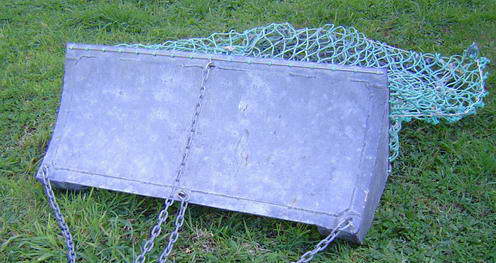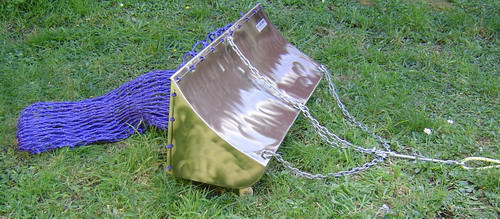|
|
The old Galvinised dredge above is where it all started. For the last twenty years or so I have been developing Hydrofoil Scallop dredges. For many years this work was a hobby that fitted in with my interest in engineering – the production of scallop dredges is now my business here in the Marlborough Sounds. My first dredges were made of mild steel and painted, while not the prettiest dredges in the world this allowed me to make modifications quickly and cheaply and this was the beginning of a long line of developments that has lasted over 20 years. It was obvious to me that although the hydrofoil design worked better than the old box dredges they still had some performance problems, combine this with operator problems and different sea floors life could get quite frustrating on the scallop beds. Once I was happy with the general design of the dredges I started having them hot dip Galvanised which gave them a good long life span. I still have one of my early Galv dredges which I still used from time to time. In my early scallop gathering days I Scuba dived the beds of Tasman Bay, Golden Bay and the Marlborough Sounds and have found that the experience has been invaluable in the development of my dredges. To understand what is happening to your dredge under water I needed to go below the surface and observe them operating and study the scallop’s environment. Scallops live in quite diverse environments from flat muddy or sandy bottoms to heavy sand waved seabeds, to small ledges on steep seafloor drop-offs. They also live up against the edge of reefs. The last two types of seafloor are totally unsuitable for dredging and should be left for scuba diving. I suggest you look for flat clear areas on the charts between 20m and 30m in depth and go tow a dredge across these areas. There are scallops all around New Zealand and there are a lot of areas that have never been dredged. I had the pleasure of working with the late Mike Bull marine biologist some years ago and he told me that when scallops spawn their eggs drift with the current’s for 21 days until they settle on objects on the seafloor and can cover large distances in that time. One area that has always been difficult to get good results dredging is Okiwi Bay on the east side of Tasman Bay. The scallop bed there has heavy sand waves along the seafloor. When you dive on beds like Okiwi you find the scallops are all down in the bottom of sandwaves. A lot of my development work was done to increase performance in this and similar areas. Most scallop beds in this area are between 20 and 30 metres depth with flat seafloor and the average dredge performs reasonably well in these conditions. |
||
|
Copyright © 2003/2004 Kev's Super Dredge® |


